McDonald’s France, environmental urgency and operational excellence

Can McDonald's France deliver on their commitment to reduce their Greenhouses Gases emissions by 2020 without compromising their state-of-the-art logistical operations ? Could this effort to reduce their carbon footprint actually be an opportunity to run better operations ?
A company at the crossroads of environmental issues
When McDonald’s France changed their iconic red and yellow logo to a golden arch on a green background in 2010, the signal was quite clear that they intended to be perceived as a leading environmentally-friendly company. Many people regarded this move as purely opportunistic and were very skeptical about McDonald’s France’s (further referenced as McDF) capacity to deliver on their promises. After all, McDF is at the crossroads of many issues related Global Warming. From the ingredients they use to their energy consumption, their logistical operations or to their waste management, McDF needed to rethink the way they operate a very profitable business. We will focus on the logistical changes that McDF has operated to comply with a growing pressure to reduce their Greenhouse gases emissions.
Facing consumer pressure in a strategic market:
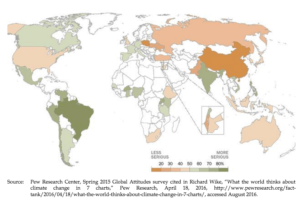 Historically, France has been a strategic market for McDonald’s, totalling 17% of the group’s global sales ($4.6B of the $27.4B annual sales in 2014) {1}. Generally, McDonald’s has gained a strong place in the French culture by providing a place to meet and work and by employing many young people. However, this structuring role in the French society comes at the price of being very scrutinised and expected to behave as a role model in their efforts to be more sustainable, specifically in a market where approximately 60% of the population considers Climate Change as a “very serious problem”{2}. To respond to popular pressure, McDF has pledged to reduce their greenhouse gases emissions by 20% by 2020. {3}
Historically, France has been a strategic market for McDonald’s, totalling 17% of the group’s global sales ($4.6B of the $27.4B annual sales in 2014) {1}. Generally, McDonald’s has gained a strong place in the French culture by providing a place to meet and work and by employing many young people. However, this structuring role in the French society comes at the price of being very scrutinised and expected to behave as a role model in their efforts to be more sustainable, specifically in a market where approximately 60% of the population considers Climate Change as a “very serious problem”{2}. To respond to popular pressure, McDF has pledged to reduce their greenhouse gases emissions by 20% by 2020. {3}
Can operations be improved while minimizing carbon footprint ?
While McDF has taken actions on the different fields mentioned above, they reviewed their logistical practices and have implemented measures to become more efficient in their operations.
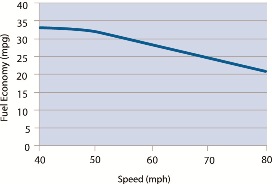 The first initiative that McDF took was to reduce the speed of their trucks to 50 mph instead of the legal 60.1mph. McDF operated a tradeoff, deciding to have longer delivery times but to make substantial cost reductions on gasoline and limit their greenhouse gases emissions. Reducing the speed from 60 mph to 50mph allowed McDF’s truck to drive at a 28 miles/gallon average instead of 33 miles/gallon {4}, hence saving up to 15% of their gasoline consumptions, in a market where gasoline is heavily taxed (average of $3.07 taxes per gallon in France, $0.53 in the US). {5}
The first initiative that McDF took was to reduce the speed of their trucks to 50 mph instead of the legal 60.1mph. McDF operated a tradeoff, deciding to have longer delivery times but to make substantial cost reductions on gasoline and limit their greenhouse gases emissions. Reducing the speed from 60 mph to 50mph allowed McDF’s truck to drive at a 28 miles/gallon average instead of 33 miles/gallon {4}, hence saving up to 15% of their gasoline consumptions, in a market where gasoline is heavily taxed (average of $3.07 taxes per gallon in France, $0.53 in the US). {5}
Another initiative that McDF has been piloting is aimed at maximizing the utilization of their truck fleet. Operating adjustments to their logistical partners’ trucks (a company named Martin Brower) and building compartments allowing their trucks to carry every type of products from “frozen” to “dry” or “fresh” products altogether has allowed McDF to maximize the utilization of their trucks and minimize the number of deliveries. By making each of their trucks fuller, they manage to save costs on their logistics. These changes have been made possible by the long-lasting relationship existing between McDF and Martin Brower and by the importance of McDF as a customer for their logistical partner. {6}
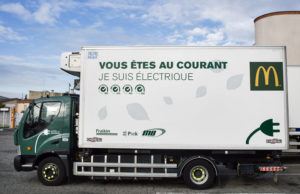 Along this line of maximizing their operational efficiency and to minimize the costs of their logistics, McDF and Martin Brower are now using electrical vehicles for the “last mile” deliveries . Last mile deliveries are the final step of the supply chain, when a good is transported from a hub (McDF’s warehouses) to the final destination (the restaurants). While electric vehicles would not be a viable option for McDF for the “hub-to-hub” deliveries of for the longer distances, due to the current technology limitations, these vehicles can be used for the last mile deliveries, allowing McDF to make substantial savings on gasoline and reduce further their CO2 footprint, while using the trucks to communicate their initiative to the public. With the latest technologies in electrical vehicles, McDF will be able to expand this program to longer journey.
Along this line of maximizing their operational efficiency and to minimize the costs of their logistics, McDF and Martin Brower are now using electrical vehicles for the “last mile” deliveries . Last mile deliveries are the final step of the supply chain, when a good is transported from a hub (McDF’s warehouses) to the final destination (the restaurants). While electric vehicles would not be a viable option for McDF for the “hub-to-hub” deliveries of for the longer distances, due to the current technology limitations, these vehicles can be used for the last mile deliveries, allowing McDF to make substantial savings on gasoline and reduce further their CO2 footprint, while using the trucks to communicate their initiative to the public. With the latest technologies in electrical vehicles, McDF will be able to expand this program to longer journey.
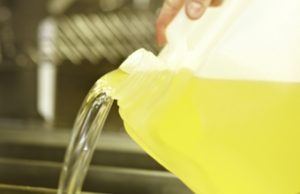 Finally, McDF and Martin Brower have rolled out an innovative program aiming at recycling the deep fry oil to power 17 trucks of their fleet. This initiative not only allows McDF to make additional savings on gasoline cost but has allowed them to start a partnership with the French Government on how this initiative could be scaled more broadly. Through this initiative, McDF might not only reduce their own carbon footprint but also help many other France-based company make their operations more effective.
Finally, McDF and Martin Brower have rolled out an innovative program aiming at recycling the deep fry oil to power 17 trucks of their fleet. This initiative not only allows McDF to make additional savings on gasoline cost but has allowed them to start a partnership with the French Government on how this initiative could be scaled more broadly. Through this initiative, McDF might not only reduce their own carbon footprint but also help many other France-based company make their operations more effective.
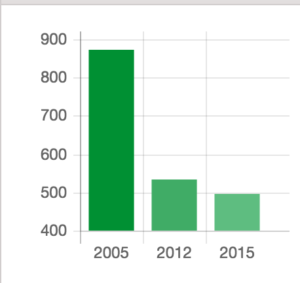
As a conclusion, McDF has been a frontrunner in terms of environmental best practices has demonstrated unique answers to these challenges by combining an approach that helped them reducing their impact on Global Warming while making their operations even more efficient. As evidence by the graph, McDF managed to cut their CO2 emission/per meal by half in 10 years. While some businesses can see the need to take action on Climate Change as a threat to their businesses’ profitability, McDF has leveraged the opportunity to improve their logistics.
797 words
Sources
{1} McDonald’s 2014 10-K report and La Croix (leading French newspaper)
{2} Pew Research Center, Spring 2015 Global Attitudes survey cited in Richard Wike, “What the world thinks about climate change in 7 charts,” Pew Research, April 18, 2016, Provided in Case Material.
{3} Company’s Website: https://www.mcdonalds.fr/entreprise/developpement-durable/gaz-a-effet-de-serre
{4} U.S. Department of Energy, gasoline economy.gov.
{6} Company website: http://www.martinbrower.fr/
{7} Company’s Website: http://www.mcdonalds-donneescorporate.fr/indicateurs/lutte-contre-le-rechauffement-climatique
Image sources, in order:
Header: Company Website https://www.mcdonalds.fr
Logo: Company Website https://www.mcdonalds.fr
Map: Case Material, Pew Research Center
Graph: U.S. Department of Energy, gasoline economy.gov.
Image: Company Website https://www.mcdonalds.fr
Image: Company Website https://www.mcdonalds.fr
Image: Company Website https://www.mcdonalds.fr
Graph: Company Website https://www.mcdonalds.fr




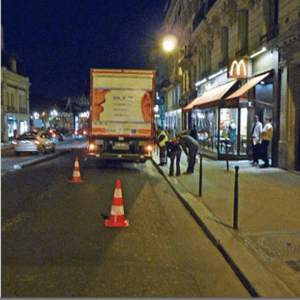
Hey Ben,
Loved your post. I had no idea McDonald’s France is doing so much do address climate change. I was surprised by the innovative program aiming at recycling the deep fry oil to power trucks. Has this kind of program been successfully implemented elsewhere?
I like to see that McDonalds France is taking action to make its logistics environmentally friendly. I also like their electrical trucks and the renewable oil to power their fleet. On top of that, I think that they should also concentrate on the sustainability of the food they are serving. Producing meat has a considerable impact in the environment in terms of CO2 generation and water consumption. Initiatives in these lines could provide sustainability in the long term completing the end to end process from raw materials creation to food delivery to customers.
Intriguing article about Micky D’s! I thought it was interesting that the driver’s are now trained and encouraged to drive significantly under the speed limit to reduce emissions, but I am suspect of the actual savings McDF is accruing. I would assume that the longer lead times on top of the extra hourly wages provided to the drivers would negate any cost savings from fuel consumption. However, if this is only a temporary change as the company eventually transitions to electric trucks, then I can see the merits. Also, i think it’s fascinating that striving for innovation for an altruistic cause can still lead to great opportunities for improving efficiency and cost savings which may be translated into direct competitive advantage. Do you know if McDF, with all of its popularity and market share in France, has pressured any other restaurants into a Collective Action agreement to support their cause?
I would be interested to find out more about their true motives i.e. whether it is to decrease costs or contribute in mitigating climate change. I would also be interested to find out whether it is a marketing stint and whether they are doing this in order to increase MCD’s reputational equity.
I would be interested to know if McDonald’s actions on climate change have been very different in France than in other countries in the world… Can we attribute this fully to as you say “popular pressure” and perception of the issue as a major public problem in France? Or if McDonald’s response is indeed stronger in France, are there other factors that could be affecting their actions and explaining why they’ve taken a more aggressive stance (i.e. regulation, management, cost structure)? In this vein, I would also be interested to know if some of the measures that McDF would be transferable to other markets. One thing that strikes me is that their supply chain innovations on delivery might not be as effective in a less dense/more sprawling environment.